February 15, 2004
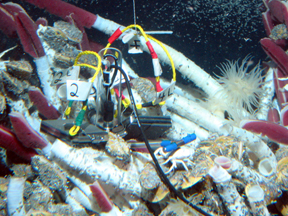
Today, Bill Seyfried and Kang Ding's chemical sensors were recovered from the Tica Vent, where they had been nestled amongst Riftia tubes. Here, you an see the handle (with blue tape) and some electronics for the sensor surrounded by basalt settlement panels.
Just another day at the office.....
Unlike most people, we eat, sleep, work and occasionally play at our office. In this case it is the R/V Atlantis. To most folks "back on the beach" our cruise sounds pretty exciting -even glamorous. There is no doubt that we really enjoy the research that we do and the results we obtain from our dives and camera tows are exciting. BUT- there are components of our research that are fairly routine and not very glamorous. For instance, the group that flies the camera sled until the wee hours of the morning are on a completely different schedule than most of the other scientists. They are heading off to bed about the time the first scientists are stirring in their bunks. Of course there are also members of the Atlantis crew that have night shifts in order to keep the ship functioning and to run the nighttime operations for the scientific staff. Generally at any time of the night, one can find one of the night crew foraging through the galley in search of something good to eat. Our kind mess crew always leave leftovers for the night raiders. Come dawn, the night workers have a decision to make: to eat breakfast before sleeping or to wait and eat lunch or even dinner as their first meal of the day.
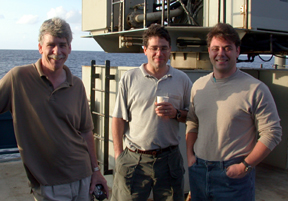
Bill Seyfried (left), Jeff Seewald, and Dionysios Foustoukos; a graduate student at the University of Minnesota. Dionysios he is waiting to climb into Alvin for his dive to the seafloor early today.
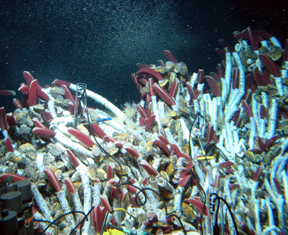
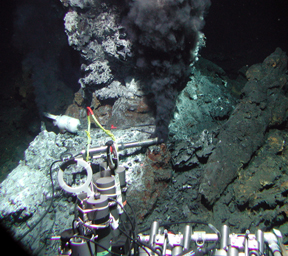
Images taken from Alvin of the hydrothermal vent sites that have been instrumented with chemical sensors, where some experiments have been deployed and direct measurements of the temperatures and chemistry of the black smokers are being made.
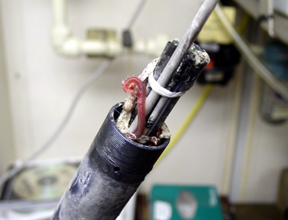 Much to the geochemists disgust and the biologists delight,
several worms (Paralvinella sp.) had moved into the cozy home provided
by the chemical sensor over the past 12 days.
Much to the geochemists disgust and the biologists delight,
several worms (Paralvinella sp.) had moved into the cozy home provided
by the chemical sensor over the past 12 days.
The morning routine:
Many of the science staff wake up in time for a delicious hot breakfast around 6:30 to 7 AM. Many of us go out to the fantail to watch the day's divers enter the "ball" and get dropped into the ocean. They have a long 1.5 hour commute to work. For the rest of us, there are no icy windshields to scrape, no children to drop at school, no dogs to walk and no traffic to fight..... we walk back into the lab and start work at our computers, around the map table or in the rock preparation lab. At this point in the cruise we have accumulated so much data that it takes us more than a day to process the information we obtained just the day before. Consequently we work very hard to keep up with the onslaught of new data, and we try to assimilate and digest what we have learned from the previous dives and tows. Typically, Vicki and Clare are working to determine what the exact locations of Alvin and the camera tow were on previous days. Vicki also has been producing very detailed maps of the topography of small areas of the ocean floor. These types of data allow us to make accurate geological maps of the seafloor which then help us understand how ocean floor volcanoes erupt and build the oceanic crust.
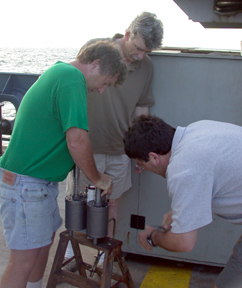
Pat Hickey, Bill Seyfried, and Jeff Seewald prepare the 'Majors' bottles. These are sampling devices that allow them to sample hydrothermal fluids at the very great pressures and temperatures on the seafloor. The fluids are analyzed onboard the ship and back on shore for major and trace element chemistry.
While locations are being determined and maps are being made, the wax guys (Ken, Ryan, Antoine) are removing the wax cores from the camera sled and going through a multistage process that allows the glass chips embedded in them to be removed for later chemical analysis, and then cleaning and re-waxing the steel balls that will be reloaded onto the camera for the next tow. In the computer/map lab John is looking at photos taken with the Rabbit Cam trying to determine what the geology of the seafloor is like and where the wax cores were taken. This will allow us to better plan our dives as well as put the composition of the glasses recovered into some geologic context. Meanwhile back in the main lab, Maurice is busy trying to make some sense of those wild and crazy magnetic wiggles that are measured by the magnetometer. He seems to be making progress because the maps of magnetic intensity he makes are looking better each day.
Yuri is processing video clips (that are being generated by Stace and Wolfgang) taken by Alvin's cameras and turning them into fantastic mosaics of portions of the seafloor while Adam is working hard to get yesterdays Alvin and camera tow images on to the ships web browser so that the rest of us can start to look at them. The "hydro guys (Bill, Jeff, Kang and Cajun are making sure their equipment is ready to be deployed again and anayzing data from their last dives. Mike, Ian and John (in various combinations) spend a good deal of time describing the Alvin rock samples from the previous days dive and then meticulously chipping glass from them. The volcanic glass will be to be carried back to their various labs for geochemical analysis over the next few months. The "bio people" (Stace, Cara, Wolfgang, Rhgian and Antoine) are preparing experiments and equipment to be placed on the seafloor by Alvin and samples of slimy biostuff to be brought back to labs at WHOI and Portland State U. for later analysis. Hans is a fixture in the main lab where he is always hard at work attempting to assimilate all of the information and come up with some models and novel ideas to explain how oceanic crust develops and how the magnetic patterns are related to crustal construction.
So, you might ask...what is Dan doing during all of this? Well, the real question is what isn't Dan doing? His boundless energy and concern for getting high quality data (in a timely fashion) requires him to speed around the labs in a manner that can only be equated with a whirling dervish or maybe one of the steel balls in a pinball machine.

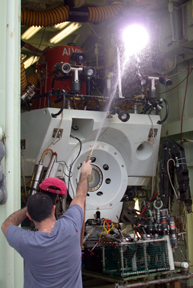
Expedition Leader, Pat Hickey adjusts a new 1200 watt light that has been added to Alvin that provides more light on the seafloor and results in better photos and video. On the right, Pilot Tony Tarantino directs a spray of water on the light to keep it cool and test for leaks.
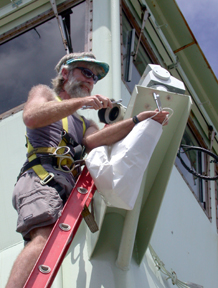
Tim Logan, the ships communication expert, adjusts one of the ships cameras that allows the ships personnel to monitor what is happening at many locations on the decks.
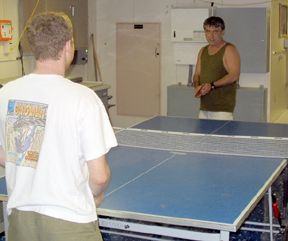
There is some time for play. Adam Soule (left) and Captain, George Silva, play a game of ping pong. Although the Captains face suggests this is a serious event, he is having fun. There is an added dimension to this game at sea because the table moves around as the ship rocks!
After lunch, most of the scientists jump right back into their work. Much has to be finished before the sub. pops up on the surface again around 5pm. The rock lab must be cleared of samples. The Rabbit Cam needs to be ready for it's nightly tow. Maps for the next day's dive have to be prepared. Yesterday's videos need to be copied.
When the sub is finally retrieved and safely back on board, the science group gathers anxiously around the fantail waiting to see what samples came back and to hear the details of the days dive. Within hours, the samples are carefully unloaded and cataloged, video and still images are downloaded to computers, the magnetometer is removed, and the TowCam it readied for it's nightly journey.
Dinner punctuates the activity but soon after the 24 hour work routine continues into the night.
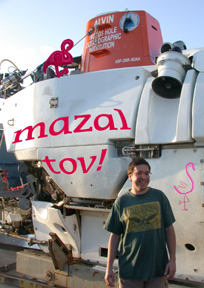
Javier's THIRD and final birthday wish - to his loving wife, Smadar